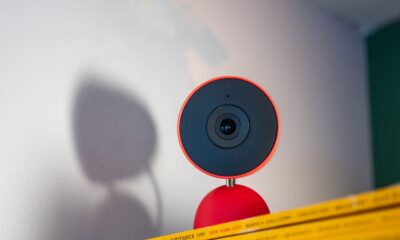Tech
Requtech retrofit programme sees creation of Satcom hub | Computer Weekly

Requtech has announced the launch of a satellite communications (Satcom) hub retrofit programme, aimed at modernising its Satcom hubs across Europe and beyond.
Founded in 2009 and now based in the Swedish city of Linköping, Sweden – known as the aviation and space capital – Requtech had the initial vision to disrupt the Satcom industry by setting new benchmarks in quality, efficiency and sustainability. It claims to be at the forefront of satellite communication technology, specialising in developing high-performance, reliable satellite communication systems. Its stated mission is to “revolutionise” communication capabilities, enhancing global connectivity through innovative services.
The company says it was built on three fundamental pillars that define both its name and mission: research, quality and technology. These principles are attributed by the company to have driven its journey from a specialised antenna design house to a leading innovator in Satcom services across geostationary, low-Earth and mid-Earth orbital satellite constellations.
Since inception, the company has developed over 100 Satcom systems, deployed in more than 40 countries for 60 diverse clients. Initially focusing on custom parabolic antenna designs, it has expanded to offer a product line comprising phased array and flyaway terminals, optimised for modern satellite constellations.
The retrofit programme will begin with a full Ka-band upgrade in a Nato country in close partnership with a leading hub operator. The Ka-band retrofit includes complete design, build and installation of the RF chain, covering the feeder, antenna horn and all associated components. The Requtech team will be involved throughout the entire process to deliver what is seen as “seamless” integration and optimised performance.
“With decades of experience in antenna design, including successful deployments of parabolic, phased array and troposcatter antennas, we are proud to expand our expertise into the infrastructure side of Satcom,” said Requtech CEO Omid Sotoudeh. “Our ability to deliver complete antenna systems now extends to full hub retrofits, allowing us to support operators with robust, future-ready solutions that meet the highest standards of performance and reliability.
“As experts in antenna and RF design, we believe in building strong, collaborative relationships. We warmly welcome partnerships with hub providers, value-added resellers and operators who share our vision for resilient and scalable Satcom infrastructure. Our goal is not to compete, but to complement, bringing deep technical expertise and a spirit of cooperation to every project. We look forward to offering these retrofit services to additional Satcom hub operators seeking reliable, scalable and mission-ready upgrades.”
Following the Ka-band deployment, the company will extend the retrofit services to Ku-band hubs, applying the same approach to deliver high-throughput connectivity.
The retrofit programme comes hot on the heels of Requtech announcing investment from Swedish defence technology company Evallic.
The investment sees Evallic’s entry into the Satcom market, which it says is crucial to enable secure communication in defence, government and critical infrastructure, offering Requtech backing and scale.
Evallic has customers in over 30 countries and operational deployments across more than 95% of Nato member states, offering systems that enhance situational awareness, decision-making and operational effectiveness.
Tech
How blind and low-vision users manage their passwords

Passwords remain the go-to authentication tool in everyday life, says CISPA researcher Alexander Ponticello. At the same time, passwords are often a security weak spot: too short, too simple, and reused far too often. Blind and low-vision people face an additional hurdle: Systems need to work together sensibly for authentication processes to run smoothly.
A new qualitative study with 33 U.S. participants shows how this group manages passwords—and where improvements are needed. Ponticello presented his paper “How Blind and Low-Vision Users Manage Their Passwords” at the IT security conference CCS 2025 in Taipei.
Passwords are still the default tool for online security—but they’re also a constant source of problems. Many people today have hundreds of accounts and for which they must manage passwords of varying complexity. Password managers can help: They create strong passwords, store them, and autofill login credentials—problem solved, right?
Unfortunately, this isn’t the case, because password managers are far from being used consistently by everyone. Previous studies show that the main reasons are the fear of complicated setup, lack of trust, and lack of knowledge about existing tools. Older user groups also tend to be generally hesitant about digital tools. Ponticello’s new study expands research on password management and password manager use to a group that has received little attention so far: blind and low-vision users.
Widespread use of password managers in the community
Password managers can be an important tool for blind and low-vision people to manage their login credentials. “In fact, all 33 respondents in our study used password managers—sometimes consciously, sometimes unconsciously, simply because their browser or device offered to manage them,” says Ponticello. These included third-party programs such as LastPass or 1Password, as well as browser-integrated password managers like the one built into Google Chrome and system-integrated password managers such as Apple Passwords.
“Those who intentionally chose a password manager usually relied on recommendations from acquaintances or advice in relevant forums. Accessibility played at least as important a role as system security,” Ponticello explains.
Real accessibility only if systems work together
“Depending on the degree of impairment, blind and low-vision users rely primarily on screen readers to use their devices in everyday life. Our first intuition was that it must be a big problem that screen readers read passwords aloud in public. However, this proved to be less of a problem, as almost all study participants told us that they use headphones,” says the researcher.
In addition, the speech output usually runs so fast that bystanders can hardly understand anything. However, for blind and low-vision people to use password managers smoothly, screen readers, password managers, apps, and websites must work together accordingly.
“If one of these parties fails, the whole system breaks down,” says Ponticello.
Unfortunately, there are still programs where accessibility seems to be an afterthought. At the latest when updates need to be installed, some users have experienced that programs no longer work properly. The result: Users feel they cannot reliably depend on the systems.
Security versus everyday life: Compromises are common
Many of the users surveyed therefore combine password managers with backup strategies. Some even keep password lists in Braille—safely stored, but still analog.
“That’s not inherently insecure,” the researcher explains. “But you have to be aware of who might have access to that list.” Other study participants said they intentionally create simpler passwords so they can enter them without a tool if necessary.
“That contradicts security best practices,” he says, “but above all it shows that systems need to become more reliable.”
What (still) needs to be done—and how to do it better
According to Ponticello, one problem is how password managers generate passwords: Random passwords with special characters are often hard for blind people to find on the keyboard. A better alternative would be passphrases that string whole words together.
“Unfortunately, screen readers then read those passwords letter by letter instead of recognizing the words. The integration hasn’t been thought through to the end,” the researcher says. App stores could also help by clearly labeling a tool’s accessibility and introducing special review categories for affected users where blind and low-vision people can get information directly.
“But the most important thing is: We need accessibility by design—correct labels for buttons, a sensible focus order, and consistent screen reader flows.”
Outlook
Conducting a similar study with German users could be Ponticello’s next step. So far, legislation in the U.S. has been stricter than in the EU. Laws such as the Americans with Disabilities Act have long enforced strict accessibility standards for websites and digital services there. The EU is following suit with the European Accessibility Act (EAA).
In Germany, this led to the Accessibility Strengthening Act, which has been required to be applied since June 28, 2025. “I’m curious to see what effects this will have in the future,” says Ponticello.
Ponticello’s study shows: Accessibility is not a luxury but a basic prerequisite for digital security. Many hurdles—from lack of labeling to fragile integrations—can be solved if platforms, developers, and lawmakers take them seriously.
“We need to adapt the systems, not the people,” the researcher says. “Only then can passwords be used securely by everyone.”
More information:
How Blind and Low-Vision Users Manage Their Passwords. cispa.de/en/research/publicati … nage-their-passwords
Provided by
CISPA Helmholtz Center for Information Security
Citation:
How blind and low-vision users manage their passwords (2025, October 27)
retrieved 27 October 2025
from https://techxplore.com/news/2025-10-vision-users-passwords.html
This document is subject to copyright. Apart from any fair dealing for the purpose of private study or research, no
part may be reproduced without the written permission. The content is provided for information purposes only.
Tech
Here’s How Many People May Use ChatGPT During a Mental Health Crisis Each Week

OpenAI says the medical experts reviewed more than 1,800 model responses involving potential psychosis, suicide, and emotional attachment and compared the answers from the latest version of GPT-5 to those produced by GPT-4o. While the clinicians did not always agree, overall, OpenAI says they found the newer model reduced undesired answers between 39 percent and 52 percent across all of the categories.
“Now, hopefully a lot more people who are struggling with these conditions or who are experiencing these very intense mental health emergencies might be able to be directed to professional help, and be more likely to get this kind of help or get it earlier than they would have otherwise,” Johannes Heidecke, OpenAI’s safety systems lead, tells WIRED.
While OpenAI appears to have succeeded in making ChatGPT safer, the data it shared has significant limitations. The company designed its own benchmarks, and it’s unclear how these metrics translate into real-world outcomes. Even if the model produced better answers in the doctor evaluations, there is no way to know whether users experiencing psychosis, suicidal thoughts, or unhealthy emotional attachment will actually seek help faster or change their behavior.
OpenAI hasn’t disclosed precisely how it identifies when users may be in mental distress, but the company says that it has the ability to take into account the person’s overall chat history. For example, if a user who has never discussed science with ChatGPT suddenly claims to have made a discovery worthy of a Nobel Prize, that could be a sign of possible delusional thinking.
There are also a number of factors that reported cases of AI psychosis appear to share. Many people who say ChatGPT reinforced their delusional thoughts describe spending hours at a time talking to the chatbot, often late at night. That posed a challenge for OpenAI because large language models generally have been shown to degrade in performance as conversations get longer. But the company says it has now made significant progress addressing the issue.
“We 1761584905 see much less of this gradual decline in reliability as conversations go on longer,” says Heidecke. He adds that there is still room for improvement.
Tech
17 Thoughtful Gifts for Your Coworkers That Are Under $50

Every office is a microcosm of personalities, making the quest for the best gifts for coworkers exciting and baffling. You’ve got the snack lover, whose bottomless drawer of treats resembles a mini convenience store, always offering a morsel during that mid-afternoon slump. There’s the wellness enthusiast, ever zealous to remind us to take a break and breathe. And let’s not forget the Gen Zer, a beacon of pop culture, stocked with podcast recommendations and eager to draw you into their latest binge-worthy obsession.
Even if your team is remote, these quirks show in the little details: Zoom backgrounds that reveal snippets of our personal lives, Slack banter that often teeters on the line between productivity and procrastination, and those GIFs we can’t help but overuse. Shopping for gifts for coworkers can feel daunting, but you probably know them better than you think.
To help you brainstorm and reflect on some of the characters in your work environment, we’ve rounded up thoughtful gifts that cater to every persona, from the foodie to the tech whiz. Don’t see anything you like? Don’t press Checkout on that lazy gift card just yet—explore our other gift giving guides, from travel gifts to gifts for women, and our favorite stocking stuffers.
Updated October 2025: I’ve added the Pura Mini smart home fragrance diffuser and the Spigen OneTap Pro 3 Cryomax wireless charger. I’ve also updated prices and links.
-

 Tech1 week ago
Tech1 week agoHow to Protect Yourself Against Getting Locked Out of Your Cloud Accounts
-

 Tech1 week ago
Tech1 week agoThe DeltaForce 65 Brings Das Keyboard Into the Modern Keyboard Era—for Better or Worse
-

 Business1 week ago
Business1 week agoGovernment vows to create 400,000 jobs in clean energy sector
-

 Business1 week ago
Business1 week agoDiwali 2025: Gold & silver likely to consolidate next week; Here’s what analysts said – The Times of India
-

 Tech1 week ago
Tech1 week agoGemini in Google Home Keeps Mistaking My Dog for a Cat
-

 Fashion1 week ago
Fashion1 week agoReal UK GDP grows 0.3% QoQ in quarter to Aug 2025: ONS
-

 Business1 week ago
Business1 week agoInflation expected to jump to highest since January last year
-

 Fashion6 days ago
Fashion6 days agoChinese woman charged over gold theft at Paris Natural History Museum






